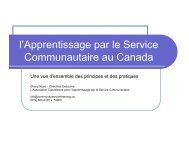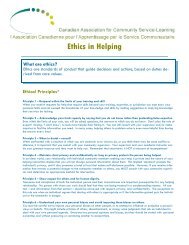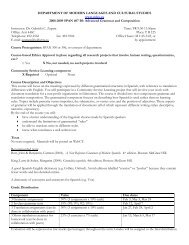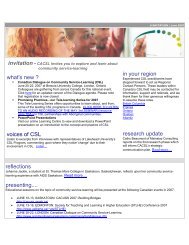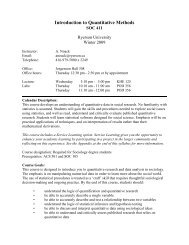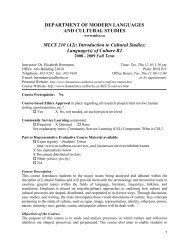Reflection - Canadian Association for Community Service Learning
Reflection - Canadian Association for Community Service Learning
Reflection - Canadian Association for Community Service Learning
You also want an ePaper? Increase the reach of your titles
YUMPU automatically turns print PDFs into web optimized ePapers that Google loves.
Tip 2 - Three key questions to take you beyonddescription: What? So what? Now what?What?: Start by describing and examining what happened duringyour voluntary experience. This includes observations about your ownand other people’s thoughts, feelings, and behaviours.So what?: Make meaning of ‘what’ happened. Move the solutionsthat are found. Explore how theory can be used to improve practice.Explore how practice can be used to improve theory. your thinkingfrom description to analysis and interpretation. Explore how theacademic concepts you are learning in your lectures and readings relateto your experiences.Now what?: Identify how what you have learned can be used in thereal world. Explore how one’s understanding of a social issue affectsthe solutions that are found. Explore how theory can be used to improvepractice. Explore how practice can be used to improve theory.Tip 3: Broaden your view by moving from Portrait to Landscape ThinkingSimilar to photography, how you frame an issue affects what you see and the solutions youseek. Portrait frames explore issues by focusing primarily on people or events in a particularmoment in time, while ignoring contextual in<strong>for</strong>mation. Portrait frames lead people tofocus on personal responsibility <strong>for</strong> social issues. Landscape frames, on the other hand,take a broader view to examining an issue: people’s lives and events are examined in relationto the policies, institutions, and larger social, political, economic, and historical<strong>for</strong>ces that surround them. Landscape frames lead to an understanding of the shared responsibilityof individuals and society <strong>for</strong> social issues.Tip 4: Dig deeper by asking ‘why?’ atleast three times!A simple strategy <strong>for</strong> deepening your analysis is toquestion your answers by asking “why?” at leastthree times. This encourages you to look beyondwhat is immediately evident and get closer to rootissues.Tip 5: Know yourselfYou will be more effective in yourwork if you are both self‐ aware (i.e.,knowing who you are, what youbring to the project, and how youwant to grow) and socially aware(i.e., understanding complex socialissues).References:Bringle, R.G. and Hatcher, J.A (2003). <strong>Reflection</strong> in service learning: Making meaning of experience.In Campus Compact (2005). Introduction to service-learning toolkit: Readings and resources<strong>for</strong> faculty, second edition. Providence, RI: Campus Compact.Dorfman, L., Wallack, L., and Woodruff, K. (2005). More than a message: Framing public healthadvocacy to change corporate practices. Health education and Behavior, 32(3), 320-336.Ginwright, S. and Cammarota, J. (2002). New terrain in youth development: The promise of asocial justice approach. Social Justice, 29(4), 82 – 95.Scriven, M. and Paul, R. (n.d). Defining critical thinking. Retrieved January 4, 2008 from http://www.criticalthinking.org/aboutCT/define_critical_thinking.cfm





